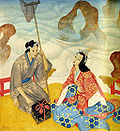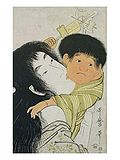- Obake
-
Part of the series on
Japanese Mythology & Folklore

Mythic Texts and Folktales:
Kojiki | Nihon Shoki | Fudoki
Kujiki | Kogo Shūi | Nihon Ryōiki
Otogizōshi | Oiwa | Okiku | Urashima Tarō
Konjaku MonogatariDivinities
Izanami | Izanagi | Amaterasu
Susanoo | Ame-no-Uzume | Inari
Kami | Seven Lucky Gods | List of divinitiesLegendary Creatures & Spirits
Oni | Kappa | Tengu | Fox | Yōkai
Dragon | Yūrei | List of creaturesLegendary Figures
Abe no Seimei | Benkei | Kintarō
Momotarō | Tamamo-no-Mae | SōjōbōMythical & Sacred Locations
Mt. Hiei | Mt. Fuji | Izumo | Ryūgū-jō | Takamagahara | Yomi | JigokuSacred Objects
Amenonuhoko | Kusanagi | Tonbogiri
Three Sacred TreasuresShintō & Buddhism
Bon Festival | Setsubun | Ema | Torii
Shinto shrines | Buddhist templesFolklorists
Kunio Yanagita, Keigo Seki, Lafcadio Hearn, Shigeru Mizuki, Inoue EnryoObake (お化け) and bakemono (化け物) are a class of yōkai, preternatural creatures in Japanese folklore. Literally, the terms mean a thing that changes, referring to a state of transformation or shapeshifting.
These words are often translated as ghost, but primarily they refer to living things or supernatural beings who have taken on a temporary transformation, and these bakemono are distinct from the spirits of the dead.[1] However, as a secondary usage, the term obake can be a synonym for yūrei, the ghost of a deceased human being.[2]
A bakemono's true form may be an animal such as a fox (kitsune), a raccoon dog (tanuki), a badger (mujina), a transforming cat (bakeneko), the spirit of a plant — such as a kodama, or an inanimate object which may possess a soul in Shinto and other animistic traditions. Obake derived from household objects are often called tsukumogami.
A bakemono usually either disguises itself as a human or appears in a strange or terrifying form such as a hitotsume-kozō, an ōnyūdō, or a noppera-bō. In common usage, any bizarre apparition can be referred to as a bakemono or an obake whether or not it is believed to have some other form, making the terms roughly synonymous with yōkai.[3]
Contents
In Hawaii
Due to the influence of a sizable Japanese immigrant population on the islands of Hawaii, the term obake has found its way into the pidgin vocabulary of the local people. Some Japanese stories concerning these creatures have found their way into local culture in Hawaii: numerous sightings of kappa have been reported on the islands, and the Japanese faceless ghosts called noppera-bō have also become well-known in Hawaii under the name mujina. This name confusion seems to have stemmed from a story by Lafcadio Hearn titled "Mujina", a story about a badger (mujina) which takes the form of a noppera-bō, rather than being one itself, which first introduced the faceless ghost to the Western world.
Hawaiian folklorist Glen Grant was known for his "Obake Files", a series of reports he developed about supernatural incidents in Hawaii. The grand bulk of these incidents and reports were of Japanese origin or concerned obake.[4]
Notes
- ^ Mayer p. 89
- ^ Daijirin and Daijisen definitions of obake.
- ^ Daijirin and Daijisen dictionary definitions.
- ^ Grant
References
- Mayer, Fanny Hagin (March 1974). "Religious Concepts in the Japanese Folktale" (PDF). Japanese Journal of Religious Studies 1 (1): 73–101. http://www.nanzan-u.ac.jp/SHUBUNKEN/publications/jjrs/pdf/3.pdf. Retrieved 2006-01-01.
- Grant, Glen; Ross Yamanaka (May 1994). Obake: Ghost Stories in Hawaii. Honolulu: Mutual Pub Co. ISBN 1-5664-7320-9.
Definitions from two major Japanese dictionaries:
- "Daijisen: Bakemono" (in Japanese). Yahoo Japan Jisho. http://dic.yahoo.co.jp/dsearch?enc=UTF-8&p=%E5%8C%96%E3%81%91%E7%89%A9&stype=0&dtype=0. Retrieved 2007-01-01.
- "Daijirin: Bakemono" (in Japanese). Yahoo Japan Jisho. http://dic.yahoo.co.jp/dsearch?p=%E5%8C%96%E3%81%91%E7%89%A9&enc=UTF-8&stype=0&dtype=0&dname=0ss. Retrieved 2007-01-01.
- "Daijisen: Obake" (in Japanese). Yahoo Japan Jisho. http://dic.yahoo.co.jp/dsearch?enc=UTF-8&p=%E3%81%8A%E3%81%B0%E3%81%91&stype=0&dtype=0. Retrieved 2007-01-01.
- "Daijirin: Obake" (in Japanese). Yahoo Japan Jisho. http://dic.yahoo.co.jp/dsearch?p=%E3%81%8A%E3%81%B0%E3%81%91&enc=UTF-8&stype=0&dtype=0&dname=0ss. Retrieved 2007-01-01.
External links
- "Japanese Ghosts" by Tim Screech in Mangajin no. 40
- "The Obakemono Project", a detailed and illustrated database of obakemono.
- Tales of Ghostly Japan
Japanese folklore 
Folktales 
Text collections Legendary creatures Categories:- Japanese legendary creatures
- Japanese words and phrases
Wikimedia Foundation. 2010.
